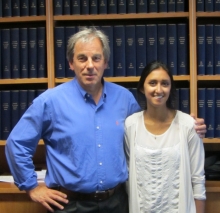
University:
Major:
Site Abroad:
Mentor(s):
Faculty Sponsor(s):
Faculty Sponsor's Department:
Project Title:
Project Description:
The extra cellular matrix (ECM) of human tissues is a gel-like fibrous structure that regulates cell fate (adhesion, proliferation, and differentiation). When the natural regeneration process is hampered by severe injuries and degenerative diseases, the use of artificial materials might be required to give cells the required cues. This is the basis of regenerative medicine, very different from the conventional therapies in which the injured organ is substituted by a non-biological part (e.g. bone prosthesis). In regenerative medicine the artificial ECM should be able to instruct cells to take over the regenerative process and reconstruct a fully functional tissue. For this purpose, biologically active peptide amphiphiles (PA) are particularly promising, because they self-assemble into nanofibers that resemble the ECM morphological nanostructure. It has been demonstrated this class of molecules can trigger the regeneration process. In general, PA’s are composed entirely of essential elements of mammalian cells (amino acids, fatty acids, etc), and for that reason, its degradation products are regarded as non-toxic. Furthermore, these peptide amphiphiles can also be reincorporated into the newly formed tissue.
For this study, we have chosen well characterized PA molecules that are comprised of a short hydrophilic peptide region, a longer hydrophobic sequence of amino acids, and a lipid tail. The hydrophobic sequence has a strong propensity to form beta-sheet secondary structure, and the overall molecular design drives self-assembly into high-aspect-ratio cylindrical nanofibers. The hydrophobic collapse of the lipid tails acts synergistically with the formation of beta-sheet domains along the fiber’s long axis. The sequence was synthesized using standard FMOC solid-phase peptide synthesis (SPPS), in which a Methyltrityl-protected Lysine was added at the C-terminus and selectively deprotected in mild acidic conditions. Photoswitchable cyanine dyes were then coupled to the Lysine free epsilon amine. Fluorescently labeled PAs were co-assembled with non-labeled PAs; the supermolecular nanofibers were visualized using Stochastic Optical Reconstruction Microscopy (STORM).
